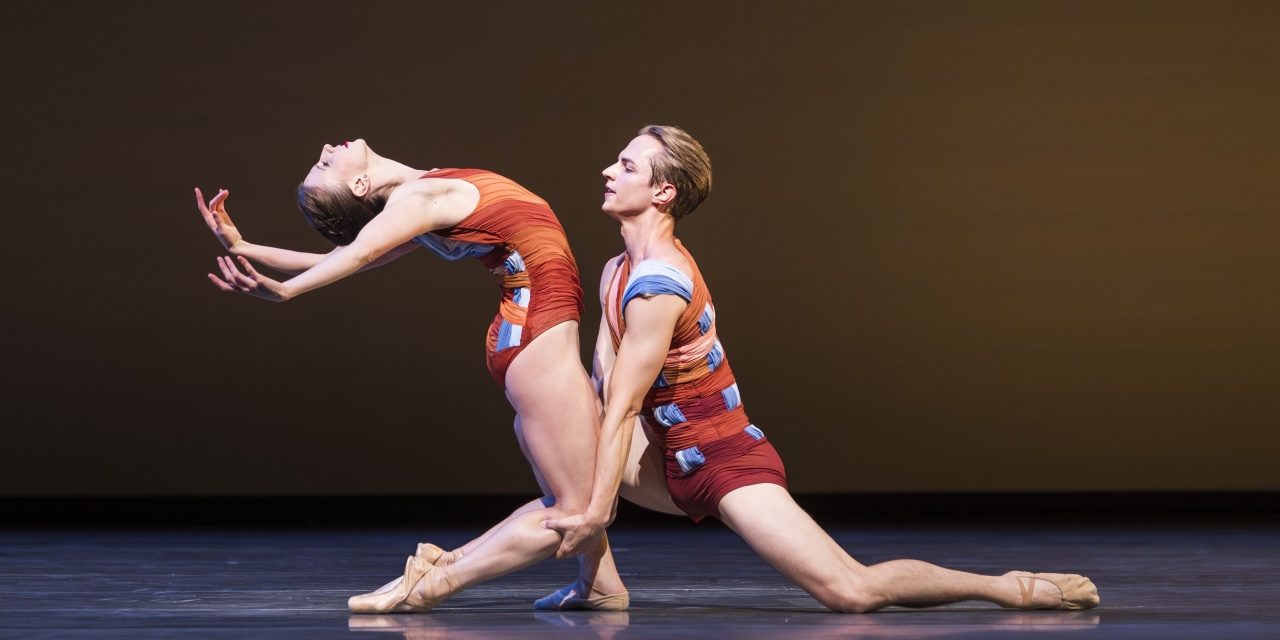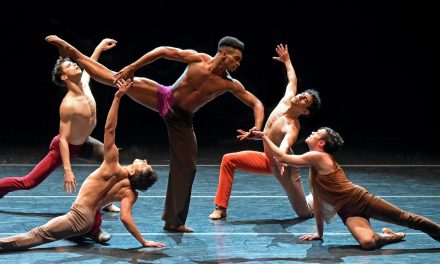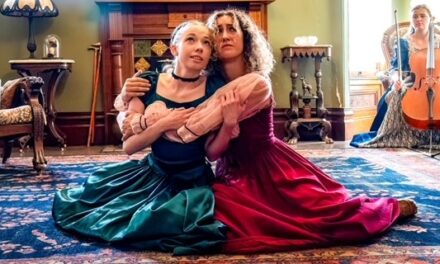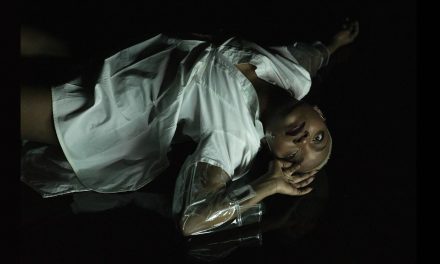Pacific Northwest Ballet’s new season has just commenced with Edwaard Liang’s “The Veil Between Worlds,” Justin Peck’s “The Times Are Racing” and the world premiere of choreographer Jessica Lang’s new work “Black Wave.”
“The Veil Between Worlds” is an ensemble piece that like a cool breeze at the end of summer hails the change of seasons. Autumnal colors saturate the stage as the dancers enter lifting high a large umber silk cloth or “veil” that floats over under and around the space and symbolically brings in the “Fall.” It is a lovely start to the night. Initially the music by Oliver Davis is uplifting as if scoring a dance of swirling leaves. Edwaard Liang’s choreography is perfectly in sync with the music and he uses his extensive vocabulary of ballet steps in easy to watch patterns and effortless staging. All of this is well presented by the terrific dancers until the final segment in which there are timing issues. In between, however, are moments of great beauty. This especially holds true with the first pas de duex elegantly danced by Leah Terada and Dammiel Cruz-Garrido to the legato strains of the violin. A mesmerizing solo by Dylan Wald follows. Sensitively interpreted and beautifully executed Wald evokes a sense of longing in the waning light of day. Liang excels with the solos and adagio/pas de duex segments but is less successful when the full ensemble is brought together. Though enjoyable he is not able to create the atmospheric high of these quieter movements. This is evidenced again by the tender final adagio as danced by Elle Macy and Dylan Wald. Here Liang has created a moment of dance perfection.
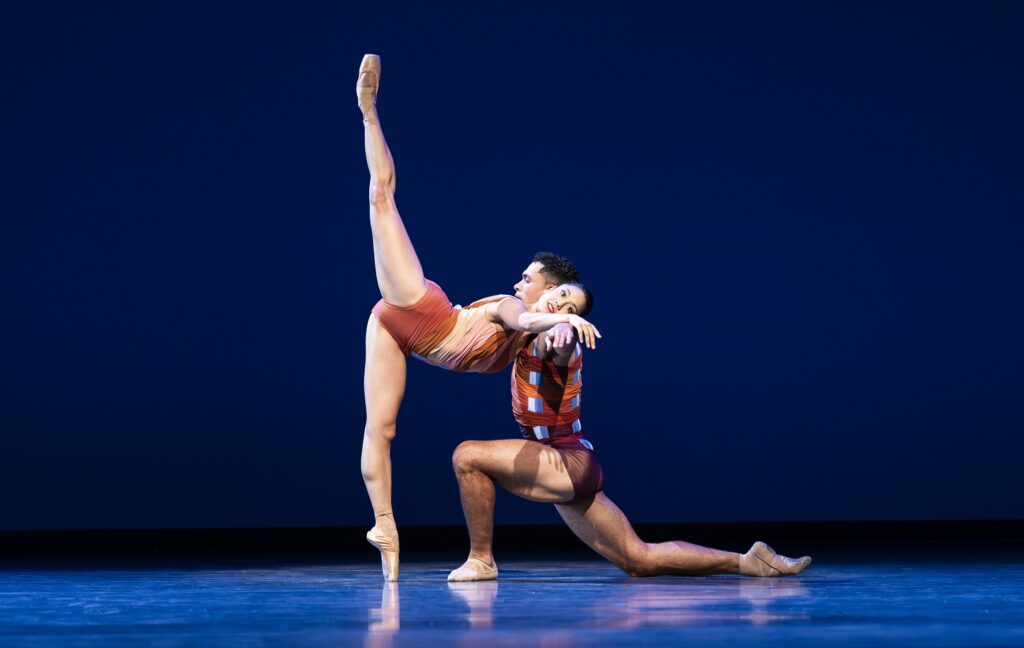
Pacific Northwest Ballet soloists Leah Terada and Dammiel Cruz-Garrido in Edwaard Liang’s “The Veil Between Worlds” – Photo © Angela Sterling.
The excellent ensemble included Sarah-Gabrielle Ryan, Larry Lancaster, Cecilia Iliesiu, Christian Poppe, Angelica Generosa and Kyle Davis.
Davis’ gorgeous musical score ranges from sprightly to melancholic and is played with nuanced perfection by the PNB orchestra led by Conductor Josh Archibald-Seiffer. Violinist Michael Jinsoo Lim brought his usual artistry to the fore.
Earthtone costumes by Mark Zappone are functional but have no flow, which the theme and music seem to call for and were missed. Perhaps a reference to the flowing silk of the “Veil” could inspire something more. The scenic design is also by Mark Zappone. Beautifully rendered lighting by Reed Nakayama was evocative of the turning season.

Pacific Northwest Ballet soloist Leah Terada with company dancers in the world premiere of Jessica Lang’s “Black Wave” – Photo © Angela Sterling.
“The Veil Between Two Worlds” was followed by the premier of “Black Wave” by PNB’S new resident choreographer Jessica Lang. A large, silhouetted tree branch hangs ominously over the starkly lit stage drawing us into a misty nether world.
Lang explains, “The work is inspired by the philosophy of kintsugi, the Japanese art of rebuilding something that is broken. Pottery breaks apart and artists reconnect it with an urushi lacquer that highlights where the pottery is broken.”
This esoteric idea may be too existentialist to be completely understood as depicted here yet, I found myself immersed in the starkly ethereal music of composer Salina Fisher, lighting designer Brandon Sterling Baker and scenic designer Libby Stadstad. Flowing costumes in icy tones by Jillian Lewis add a cool moodiness. While choreographer Lang’s work is fully immersed in classical ballet technique, here she also infuses a contemporary modernist touch. Lang builds an atmosphere of loneliness and despair as superb lead dancer Leah Terada suffers in her isolation. She continually reaches out for solace as others come in and out of the scene until finally, she is wrapped in their humanity, reconnected yet still lost like a puppet blown about by the wind.
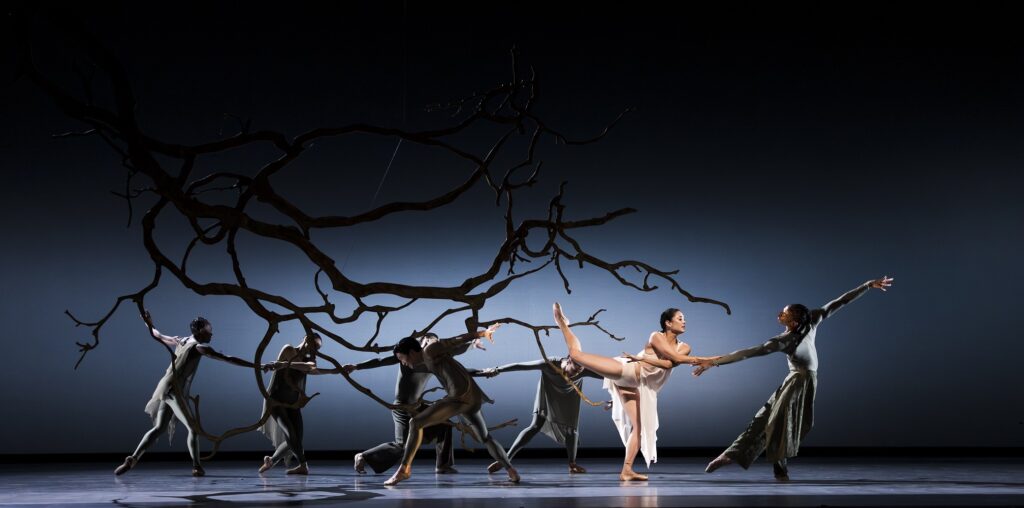
Pacific Northwest Ballet soloist Leah Terada with company dancers in the world premiere of Jessica Lang’s “Black Wave” – Photo © Angela Sterling.
Built in three sections each has its’ own musical soundscape and movement style, sometimes long languid movement, sometimes syncopated and aggressive but always interesting. When the backlit tree branch is lowered to the floor in the second section, silhouettes are created. The dancers work in this dusky light evoking the shadow art of long ago. Not only is this scene beautiful but with the music and the choreography a deep sense of nostalgia takes the stage and holds you in its’ grip.
It is clear that Ms. Lang can and does create gorgeous abstract work. In time, it would be intriguing to see what she might do with a clearly focused storyline.
The PNB Orchestra was expertly led by Emil de Cou. And as always the PNB dancers showed their excellent technique and brilliance here. They were, Leta Biascucci, Dylan Wald, Sarah-Gabrielle Ryan, Luther DeMyer, Kuu Sakuragi with, Malena Ani, Dylan Calahan, Ashton Edwards, Zsilas Michael Hughes and Audrey Malek.

Pacific Northwest Ballet company dancers in Justin Peck’s “The Times Are Racing” – Photo © Angela Sterling.
The popular “The Times Are Racing” by New York City Ballet choreographer Justin Peck closed out the program. This viewer wonders what is the intent here. Is this a ballet, a musical, or an abstract pastiche? The needle drop score by Dan Deacon is indefinable, neither soundscape nor music but more of a constant thrumming pulse. Like most choreographers of his status, Peck is not at a loss for steps, patterns, or staging. However, his storytelling and or the meaning of this ballet is indecipherable. The music sets an ominous tone as the dancers create a human shield with one person standing tall in the middle of the group. This happens three times before the music changes to something lighter but not melodious. Each section brings more confusion as to the theme or lack thereof to the ballet.
The always committed dancers are dressed by designer Humberto Leon in what could be loosely described as, high school musical attire i.e. streetwear and tennis shoes. Lighting Design by Stirling Baker is adequate but dark perhaps to compliment the drone of the score. Sound Design is by Abe Jacob.
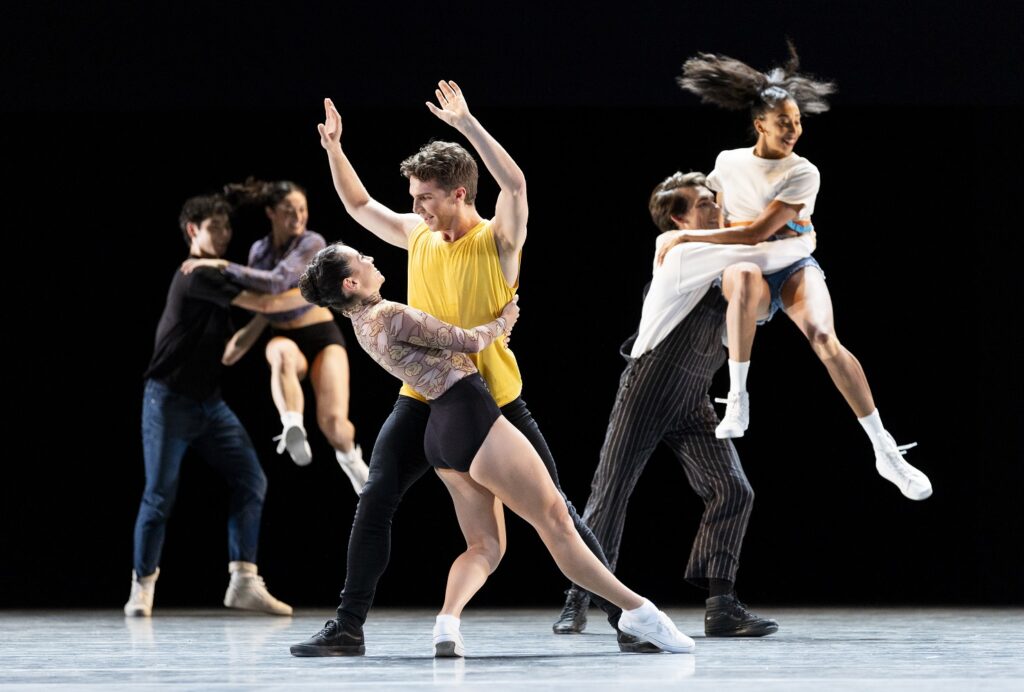
Pacific Northwest Ballet company dancers in Justin Peck’s “The Times Are Racing” – Photo © Angela Sterling.
There are several promising segments that are pleasant enough until they become overly long and repetitive. When dancers Cecilia Iliesiu, Amanda Morgan and Lily Wills join with Price Suddarth, a nice interlude begins and is enjoyable until it falls into sameness. And when Kyle Davis and Christopher D’Ariano do a pseudo jazz tap sequence there is an attempt at carefree fun that seems out of step with the musical tone. What appears to be a lover’s duet is a highlight as danced by Sarah Gabrielle Ryan and Lucien Postlewaite who together bring a sexy edge to the choreography until it too falls victim to repeating itself. In this piece Peck pulls out all the stock choreography moves, many canons, tap in tennis shoes, linking arm chains, rolling waves and whisking dancers quickly on and off stage, all to be repeated again and again. The final two minutes of mostly unison dancing is an exciting enough ending that one can almost forget what it took to get there.
Praise must be given to the PNB Company dancers who bring their full attention to every move and dance with joy and verve. Additional performers not mentioned above are, Madison Rayn Abeo, Malena Ani, Ryan Cardea, Mark Cuddihee, Melisa Guilliams, Connor Horton, Zsilas Michael Hughes, Noah Martzall, John Morrill, Ginabel Peterson, Juliet Prine, and Clara Ruf Maldonado.
Once again PNB excels at bringing new and inventive work to their audience each and every season. Anything they do is worth the time of the viewer and a gift to the world of dance.
For more information about the Pacific Northwest Ballet, please visit their website.
Written by Tam Warner for LA Dance Chronicle.
Featured image: Pacific Northwest Ballet principal dancers Elle Macy and Dylan Wald in Edwaard Liang’s “The Veil Between Worlds” – Photo © Angela Sterling.

